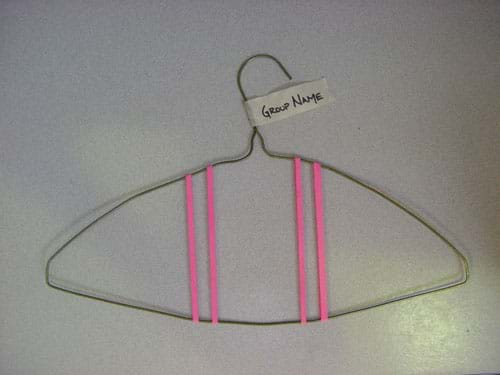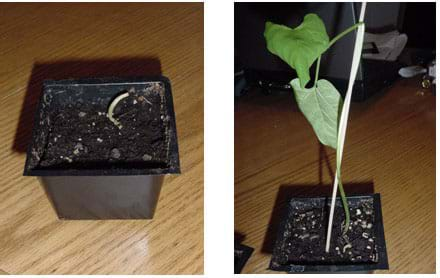Quick Look
Grade Level: 6 (4-6)
Time Required: 1 hour
Plus 1-4 weeks of daily (5 minute) data collection.
Expendable Cost/Group: US $1.00 Less if students bring wire hangers from home.
Group Size: 3
Activity Dependency: None
Subject Areas: Chemistry

Summary
Students develop an understanding of the effects of invisible air pollutants with a rubber band and hanger air test and a bean plant experiment. They also learn about methods of reducing invisible air pollutants.Engineering Connection
Since we all realize how invisible air pollutants make the air dangerous for people to breathe, some engineers make it their specialty to design vehicles, machines and manufacturing plants that emit the fewest pollutants as possible. In the US, the EPA sets emissions standards that businesses must meet to operate and engineers must follow as guidelines. An excess of pollutants can cause acid rain, a lowering of the pH of rainwater, which upsets a balanced environment and destroys agriculture and healthy vegetation.
Learning Objectives
After this activity, students should be able to:
- Identify the major types of invisible air pollutants and how they affect our health.
- Conduct a simple invisible air pollutant test.
- Explain how pollutants from the air can affect water and plant growth.
- Describe how engineers address invisible air pollution.
Educational Standards
Each TeachEngineering lesson or activity is correlated to one or more K-12 science,
technology, engineering or math (STEM) educational standards.
All 100,000+ K-12 STEM standards covered in TeachEngineering are collected, maintained and packaged by the Achievement Standards Network (ASN),
a project of D2L (www.achievementstandards.org).
In the ASN, standards are hierarchically structured: first by source; e.g., by state; within source by type; e.g., science or mathematics;
within type by subtype, then by grade, etc.
Each TeachEngineering lesson or activity is correlated to one or more K-12 science, technology, engineering or math (STEM) educational standards.
All 100,000+ K-12 STEM standards covered in TeachEngineering are collected, maintained and packaged by the Achievement Standards Network (ASN), a project of D2L (www.achievementstandards.org).
In the ASN, standards are hierarchically structured: first by source; e.g., by state; within source by type; e.g., science or mathematics; within type by subtype, then by grade, etc.
NGSS: Next Generation Science Standards - Science
-
Make observations and measurements to produce data to serve as the basis for evidence for an explanation of a phenomenon.
(Grade 5)
More Details
Do you agree with this alignment?
-
Ask questions that can be investigated within the scope of the classroom, outdoor environment, and museums and other public facilities with available resources and, when appropriate, frame a hypothesis based on observations and scientific principles.
(Grades 6 - 8)
More Details
Do you agree with this alignment?
Common Core State Standards - Math
-
Represent and interpret data.
(Grade
5)
More Details
Do you agree with this alignment?
State Standards
Colorado - Math
-
Represent and interpret data.
(Grade
5)
More Details
Do you agree with this alignment?
Colorado - Science
-
Identify evidence that suggests there is a fundamental building block of matter
(Grade
6)
More Details
Do you agree with this alignment?
Materials List
Rubber Band Air Test
Each group needs:
- 1 wire clothes hanger
- 4 identical, small rubber bands
- 1 piece masking tape
- 1 magnifying glass
- 1 index card
For the entire class to share:
- Chart paper (large, bulletin-board size)
- Colored construction paper
- Scissors
- Transparent tape
Acid Rain Activity (Bean Plant)
Each group needs:
- 3 bean plants (approximately the same size, planted in separate containers)
- Vinegar
- Tap water
- Vinegar-water mixture in 1 to 3 ratio
- Masking tape
- pH paper or indicator
- Magnifying glass
For the entire class to share:
- 1/8 cup measuring cup
- 1/4 cup measuring cup
Introduction/Motivation
It is a challenge for engineers to identify invisible air pollutants. Since they cannot see these pollutants, engineers often must base their initial information about possible pollutants on how the outdoor environment is being affected. From what they learn, engineers either develop materials resistant to the negative effects of air pollution or determine measures to reduce air pollution and improve the quality of life for the people living in that area.
Engineers study invisible air pollutants found indoors, too. Gas stoves, cigarette smoke and even breathing can emit pollutants. Many everyday items purchased in stores, especially those made of plastic, are produced in factories using chemicals and glues. Often, we can smell these pollutants, but we cannot see them. Over time, chemical pollutants are released inside homes and offices in a process called offgassing. Engineers study the presence of these pollutants in buildings and sometimes add fans (for increased ventilation) or take other actions, to remove them from the enclosed buildings, so people do not get sick from the indoor air.
Procedure
Before the Activity
Consider doing these activities simultaneously with those in this lesson. The same collection sites can be used to test for visible and invisible air pollutants.
- Activity 1: Rubber Band Air Test — Consider testing possible collection sites before the experiment. Choose sites not in direct sunlight.
- Activity 2: Acid Rain Activity (Bean Plant) — Prepare enough of the three solutions for students to use them for an extended period of time. Grow or purchase some bean plants.
With the Students
Activity 1: Rubber Band Air Test
- Divide the class into work teams of three students each.
- Distribute supplies to each group (1 hanger, 4 identical, small rubber bands, and 1 piece of masking tape for labeling the group name).
- Demonstrate how to prepare the rubber band air tester. Bend the wire hanger so the rubber bands can be stretched over the hanger (see Figure 1). Make sure the rubber bands are tight. (Place your example collector in a drawer or cupboard in your classroom, as a control.)

- Decide on several locations around the school — inside and outside — at which students think invisible pollutants may be found. Keep in mind that the collectors may have to stay at each site, undisturbed, for 1-2 weeks. (Possible locations: Near a road or parking lot, teachers' lounge or where people take smoking breaks, a stove, the classroom air filter/vent or the school's air intake/vent, etc.) Assign each group to a different collection site.
- Ask students to make predictions about which area they think has more invisible pollutants and why. Have students record their predictions in their journals or on a piece of paper.
- Have students note the initial qualities of the rubber bands. Use the magnifying glasses. Include suppleness, "stretchiness," color, texture, etc. Have the students record these observations.
- Place the hangers in the collection sites for 1-2 weeks. Have the groups check them daily, and record their observations on the condition of the rubber bands and the collection site.
- On the final day of observations, bring the hangers back to the classroom for comparison.
- Have students note the final qualities of the rubber bands. Use the magnifying glasses. Include suppleness, "stretchiness," color, texture, etc. Record these observations. (Expectations: If the rubber bands appear about the same as the beginning, then there were few invisible pollutants present at that site. If they appear cracked and hard, then there were pollutants present.)
- Have students rank the hangers from the one with the fewest effects to the one with the most. They can line them up in order across a counter or table. Remember to include the control hanger. Ask students to record this information in their journals.
- Discuss why certain areas seem to have more invisible pollutants than others.
- Remind students that they are breathing all the invisible pollutants that altered the rubber bands. Ask them to write about how they feel about this in their journals. If they were engineers, in which areas of the school would they want to try and improve the air quality?
- Make a school map on large chart paper. For each collection site, cut a hanger shape from colored construction paper and write on it the ranking and location. Adhere each cut-out hanger to the correct location on the map. What conclusions can you draw from the map? Write a few of these conclusions neatly on index cards. Display the map and index cards in a school hallway for others to see. (You can also just add hangers indicating invisible pollutants to the school map made in this lesson, if desired.)
- Hold a classroom discussion and/or make a writing assignment about possible sources of the pollution. How can we make the air more desirable to breathe? (Learn more about this in this lesson.)
Activity 2: Acid Rain Activity (Bean Plant)
- Divide the class into work teams of three students each.
- Have each group set up a garden with three bean plants, one plant per container.
- Distribute the rest of the supplies to each group: Samples of the three solutions (water only, vinegar only, vinegar-water mix [1 cup vinegar to 3 cups water], masking tape and pH test strips).
- Using masking tape, have students label each of the plant containers: Water only, vinegar only, vinegar-water solution.
- Have students use pH test strips to test the pH of the three solutions. Have them record this information in their journals. (More information about pH can be found in this lesson.)
- Ask students to predict how the plants will be affected by each solution, and record their predictions in their journals.
- Have the student teams water their plants with 1/8 to 1/4 cup of the appropriate solution for each container: one plant with tap water, one with straight vinegar, and one with the vinegar-water mixture. Record the procedure.
- Observe and water the plants with the appropriate solutions daily. What happens to each plant? Record observations. Encourage sketches to document the observations.
- Compare plants and discuss observations at the end of a day, week, two weeks, four weeks or until some plants die (see Figure 2).

- Have the students take into consideration the observations and results of all the groups and write in their journals a class conclusion for the experiment. (Tip: Arrive at the idea that the invisible pollutants experiment is similar to how air pollutants contaminate the water supply resulting in acid rain, which is damaging to living plants.) (See this lesson, for more information on acid rain.)
- Remind students that they are breathing all the pollutants that the water absorbs when it becomes acid rain. How do they think our bodies react? Would any of the reactions be similar to the plants' reactions? Ask them to write their thoughts and responses in their journals.
Assessment
Pre-Activity Assessment
Brainstorming: Have the students engage in open discussion to think of locations around the school at which invisible pollutants may be found. Remind students that no idea or suggestion is "silly." All ideas should be respectfully heard.
Prediction: Have students predict the outcome of the activity before the activity is performed.
- In the Rubber Band Air Test Activity, have students predict which collection sites might have the most pollutants.
- In the Acid Rain Activity, have students predict how they think the plants will be affected by the different solutions.
Activity Embedded Assessment
Journals: Have students be complete in recording their procedures, predictions, observations and conclusions in their journals.
Post-Activity Assessment
Informing Others / Map Making: Make a school map on large chart paper. For each collection site, cut a hanger shape from colored construction paper and write on it the ranking and location. Adhere each cut-out hanger to the correct location on the map. What conclusions can you draw from the map? Write a few of these conclusions neatly on index cards. Display the map and index cards in a school hallway for others to see. (You can also just add hangers indicating invisible pollutants to the school map made in this lesson, if desired.)
Discussion Questions: Solicit, integrate and summarize student responses on the board. Ask the students:
- What have you learned about invisible air pollution from this activity?
- What are some signs that invisible air pollution may be present in a certain area?
Safety Issues
- Make sure you place the hanger collectors in low-traffic areas to avoid having unaware students and school visitors bumping into them.
Troubleshooting Tips
Activity 1: Rubber Band Air Test
To fit the rubber bands tightly to the hanger, start with four identical rubber bands and bend the hanger slightly, as needed.
If you do not have space at your school to conduct this activity, consider asking the students to take the hangers home (as the collection site), and bring them back to school for comparison and analysis.
Activity 2: Acid Rain Activity (Bean Plant)
Most small plants are appropriate for this activity, as long as all three are of similar size. If you are sprouting the bean plants yourself, they usually germinate in 10 days, and need 10 more days of water and growth before beginning the activity. As a variation to the activity, you could test how the "polluted" water affects the germination rate.
Activity Extensions
Test the reaction of different plant types. Are some plants more tolerant of the "polluted" water?
Determine the tolerance range for the plants by experimenting with a variety of vinegar and water concentrations.
Have students make a bar graph showing the life span of the plants (vertical) vs. the pH of the solution (horizontal). What conclusions can you draw from the graph? Can you estimate what pH range the plant can tolerate?
Offgassing is the release of chemicals from non-metallic substances. Have students research to find out as many as possible ordinary everyday products and materials that are known to be offgassing, and thus possibly contributing to poor air quality. For example, cabinets made from particle board or plywood, paints, plastics, new carpets and swimming pools.
Have students research and report to the class on "sick building syndrome." What are the indicators of a "sick building" and what might be the causes? What are possible solutions? Start with information provided by the U.S. Environmental Protection Agency, Indoor Air Facts No. 4 (revised): Sick Building Syndrome (SBS) at: http://www.epa.gov/iaq/pdfs/sick_building_factsheet.pdf.
Activity Scaling
- For younger students, have them draw pictures of their observations.
Subscribe
Get the inside scoop on all things TeachEngineering such as new site features, curriculum updates, video releases, and more by signing up for our newsletter!More Curriculum Like This

Students are introduced to the concepts of air pollution and technologies that engineers have developed to reduce air pollution. They develop an understanding of visible air pollutants with an incomplete combustion demonstration, a "smog in a jar" demonstration, construction of simple particulate ma...

Students are introduced to the concepts of air pollution, air quality, and climate change. The three lesson parts (including the associated activities) focus on the prerequisites for understanding air pollution. First, students use M&M® candies to create pie graphs that express their understanding o...
References
Jones, Maclyn. Air Pollution: Visible and Invisible. Updated August 2, 2004. Lesson Plans for Teachers, TCEQ, Texas Natural Resource Conservation Commission. Accessed September 18, 2006. Formerly found at: http://www.tceq.state.tx.us/assets/public/assistance/education/air/visible_invisible.pdf
Paxton, Kim. The Rubber Band Air Test. Updated July 28, 2004. Lesson Plans for Teachers, TCEQ, Texas Natural Resource Conservation Commission. Accessed September 18, 2006. Formerly found at: http://www.tceq.state.tx.us/assets/public/assistance/education/air/visible_invisible.pdf
Copyright
© 2004 by Regents of the University of Colorado.Contributors
Amy Kolenbrander; Sharon Perez; Janet Yowell; Natalie Mach; Malinda Schaefer Zarske; Denise CarlsonSupporting Program
Integrated Teaching and Learning Program, College of Engineering, University of Colorado BoulderAcknowledgements
The contents of this digital library curriculum were developed under a grant from the Fund for the Improvement of Postsecondary Education (FIPSE), U.S. Department of Education and National Science Foundation GK-12 grant no. 0338326. However, these contents do not necessarily represent the policies of the Department of Education or National Science Foundation, and you should not assume endorsement by the federal government.
Last modified: December 11, 2020







User Comments & Tips